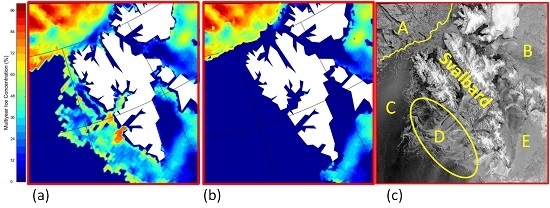Improving Multiyear Sea Ice Concentration Estimates with Sea Ice Drift
Abstract
:1. Introduction
2. The ECICE Algorithm and Data Sets
3. Misclassification of FYI as MYI
4. The Correction Scheme
4.1. Outline of the Correction Scheme
4.2. Threshold Adjustment
5. Results and Discussions
5.1. General Observations
5.2. Inter-Comparison with SAR Images
Case study (1): Ice around Svalbard
Case study (2): Ice in the Chukchi Sea
Case study (3) and (4): ice in the Greenland Sea
5.3. Inter-Annual Variability over the Entire Arctic
5.4. Regional Sensitivity to the Correction
6. Conclusions
Acknowledgments
Author Contributions
Conflicts of Interest
References
- Cavalieri, D.; Parkinson, C. Arctic sea ice variability and trends, 1979–2010. Cryosphere 2012, 6, 881–889. [Google Scholar] [CrossRef]
- Comiso, J.C. Large Decadal Decline of the Arctic Multiyear Ice Cover. J. Clim. 2012, 25, 1176–1193. [Google Scholar] [CrossRef]
- Comiso, J.C.; Parkinson, C.L.; Gersten, R.; Stock, L. Accelerated decline in the Arctic sea ice cover. Geophys. Res. Lett. 2008, 35, L01703. [Google Scholar] [CrossRef]
- Stroeve, J.; Holland, M.M.; Meier, W.; Scambos, T.; Serreze, M. Arctic sea ice decline: Faster than forecast. Geophys. Res. Lett. 2007, 34, L09501. [Google Scholar] [CrossRef]
- Comiso, J.C. Abrupt decline in the Arctic winter sea ice cover. Geophys. Res. Lett. 2006, 33, L18504. [Google Scholar] [CrossRef]
- Comiso, J.C. A rapidly declining perennial sea ice cover in the Arctic. Geophys. Res. Lett. 2002, 29. [Google Scholar] [CrossRef]
- Johannessen, O.M.; Shalina, E.V.; Miles, M.W. Satellite evidence for an Arctic sea ice cover in transformation. Science 1999, 286, 1937–1939. [Google Scholar] [CrossRef] [PubMed]
- Kwok, R. Near zero replenishment of the Arctic multiyear sea ice cover at the end of 2005 summer. Geophys. Res. Lett. 2007, 34, L05501. [Google Scholar] [CrossRef]
- Kwok, R.; Untersteiner, N. The thinning of Arctic sea ice. Phys. Today 2011, 64, 36–41. [Google Scholar] [CrossRef]
- Perovich, D.K.; Richter-Menge, J.A. Loss of sea ice in the arctic. Ann. Rev. Mar. Sci. 2009, 1, 417–441. [Google Scholar] [CrossRef] [PubMed]
- Vihma, T. Effects of Arctic Sea Ice Decline on Weather and Climate: A Review. Surv. Geophys. 2014, 35, 1175–1214. [Google Scholar] [CrossRef]
- Petrie, R.E.; Shaffrey, L.C.; Sutton, R.T. Atmospheric response in summer linked to recent Arctic sea ice loss. Q. J. R. Meteorolog. Soc. 2015, 141, 2070–2076. [Google Scholar] [CrossRef]
- Kwok, R.; Cunningham, G.; Wensnahan, M.; Rigor, I.; Zwally, H.; Yi, D. Thinning and volume loss of the Arctic Ocean sea ice cover: 2003–2008. J. Geophys. Res. Oceans 2009, 114, C07005. [Google Scholar] [CrossRef]
- Stroeve, J.C.; Serreze, M.C.; Holland, M.M.; Kay, J.E.; Malanik, J.; Barrett, A.P. The Arctic′s rapidly shrinking sea ice cover: a research synthesis. Clim. Change 2012, 110, 1005–1027. [Google Scholar] [CrossRef]
- Kwok, R.; Spreen, G.; Pang, S. Arctic sea ice circulation and drift speed: Decadal trends and ocean currents. J. Geophys. Res. Oceans 2013, 118, 2408–2425. [Google Scholar] [CrossRef]
- Notz, D. The future of ice sheets and sea ice: Between reversible retreat and unstoppable loss. Proc. Natl. Acad. Sci. USA 2009, 106, 20590–20595. [Google Scholar] [CrossRef] [PubMed]
- Shokr, M.; Dabboor, M. Interannual variability of young ice in the Arctic estimated between 2002 and 2009. IEEE Trans. Geosci. Remote Sens. 2013, 51, 3354–3370. [Google Scholar] [CrossRef]
- Haas, C.; Howell, S.E. Ice thickness in the Northwest Passage. Geophys. Res. Lett. 2015, 42, 7673–7680. [Google Scholar] [CrossRef]
- Howell, S.E.; Wohlleben, T.; Dabboor, M.; Derksen, C.; Komarov, A.; Pizzolato, L. Recent changes in the exchange of sea ice between the Arctic Ocean and the Canadian Arctic Archipelago. J. Geophys. Res. Oceans 2013, 118, 3595–3607. [Google Scholar] [CrossRef]
- Ivanova, N.; Johannessen, O.M.; Pedersen, L.T.; Tonboe, R.T. Retrieval of Arctic sea ice parameters by satellite passive microwave sensors: A comparison of eleven sea ice concentration algorithms. IEEE Trans. Geosci. Remote Sens. 2014, 52, 7233–7246. [Google Scholar] [CrossRef]
- Cavalieri, D.J.; Gloersen, P.; Campbell, W.J. Determination of sea ice parameters with the Nimbus 7 SMMR. J. Geophys. Res. Atmos. 1984, 89, 5355–5369. [Google Scholar] [CrossRef]
- Steffen, K.; Schweiger, A. NASA team algorithm for sea ice concentration retrieval from Defense Meteorological Satellite Program special sensor microwave imager: Comparison with Landsat satellite imagery. J. Geophys. Res. Oceans 1991, 96, 21971–21987. [Google Scholar] [CrossRef]
- Lomax, A.S.; Lubin, D.; Whritner, R.H. The potential for interpreting total and multiyear ice concentrations in SSM/I 85.5 GHz imagery. Remote Sens. Environ. 1995, 54, 13–26. [Google Scholar] [CrossRef]
- Comiso, J.C.; Cavalieri, D.J.; Parkinson, C.L.; Gloersen, P. Passive microwave algorithms for sea ice concentration: A comparison of two techniques. Remote Sens. Environ. 1997, 60, 357–384. [Google Scholar] [CrossRef]
- Kwok, R. Annual cycles of multiyear sea ice coverage of the Arctic Ocean: 1999–2003. J. Geophys. Res. Oceans 2004, 109, C11004. [Google Scholar] [CrossRef]
- Wang, H.; Heygster, G.; Shouzong, H.; Cheng, B. Arctic multiyear ice concentration retrieval based on AMSR-E 89GHz data. Chin. J. Polar Res. 2009, 21, 186–196. [Google Scholar]
- Ye, Y.; Heygster, G. Towards an Interdisciplinary Approach in Earth System Science: Advances of a Helmholtz Graduate Research School; Chapter Arctic Multiyear Ice Concentration Retrieval from SSM/I Data Using the NASA Team Algorithm with Dynamic Tie Points; Springer International Publishing: Cham, Germany, 2015; pp. 99–108. [Google Scholar]
- Markus, T.; Cavalieri, D.J. An enhancement of the NASA Team sea ice algorithm. IEEE Trans. Geosci. Remote Sens. 2000, 38, 1387–1398. [Google Scholar] [CrossRef]
- Shokr, M.; Lambe, A.; Agnew, T. A new algorithm (ECICE) to estimate ice concentration from remote sensing observations: An application to 85-GHz passive microwave data. IEEE Trans. Geosci. Remote Sens. 2008, 46, 4104–4121. [Google Scholar] [CrossRef]
- Shokr, M.; Agnew, T.A. Validation and potential applications of Environment Canada Ice Concentration Extractor (ECICE) algorithm to Arctic ice by combining AMSR-E and QuikSCAT observations. Remote Sens. Environ. 2013, 128, 315–332. [Google Scholar] [CrossRef]
- Voss, S.; Heygster, G.; Ezraty, R. Improving sea ice type discrimination by the simultaneous use of SSM/I and scatterometer data. Polar Res. 2003, 22, 35–42. [Google Scholar] [CrossRef]
- Tschudi, M.; Fowler, C.; Maslanik, J.; Stroeve, J. Tracking the movement and changing surface characteristics of Arctic sea ice. IEEE J. Selected Topics Appl. Earth Obs. Remote Sens. 2010, 3, 536–540. [Google Scholar] [CrossRef]
- Fowler, C.; Emery, W.; Tschudi, M. Polar Pathfinder Daily 25 km EASE-grid Sea Ice Motion Vectors; Version 2; NASA National Snow and Ice Data Center Distributed Active Archive Center: Boulder, CO, USA, 2013. [Google Scholar]
- Hoffman, R.N.; Leidner, S.M. An introduction to the near-real-time QuikSCAT data. Weather Forecast. 2005, 20, 476–493. [Google Scholar] [CrossRef]
- Comiso, J.C.; Cavalieri, D.J.; Markus, T. Sea ice concentration, ice temperature, and snow depth using AMSR-E data. IEEE Trans. Geosci. Remote Sens. 2003, 41, 243–252. [Google Scholar] [CrossRef]
- Meier, W.N.; Dai, M. High-resolution sea-ice motions from AMSR-E imagery. Ann. Glaciol. 2006, 44, 352–356. [Google Scholar] [CrossRef]
- Comiso, J.C.; Parkinson, C.L. Arctic sea ice parameters from AMSR-E data using two techniques and comparisons with sea ice from SSM/I. J. Geophys. Res. Oceans 2008, 113, C02S05. [Google Scholar] [CrossRef]
- Spreen, G.; Kaleschke, L.; Heygster, G. Sea ice remote sensing using AMSR-E 89-GHz channels. J. Geophys. Res. Oceans 2008, 113, C02S03. [Google Scholar] [CrossRef]
- Early, D.S.; Long, D.G. Image reconstruction and enhanced resolution imaging from irregular samples. IEEE Trans. Geosci. Remote Sens. 2001, 39, 291–302. [Google Scholar] [CrossRef]
- Long, D.G.; Daum, D.L. Spatial resolution enhancement of SSM/I data. IEEE Trans. Geosci. Remote Sens. 1998, 36, 407–417. [Google Scholar] [CrossRef]
- Long, D.G.; Hardin, P.J.; Whiting, P.T. Resolution enhancement of spaceborne scatterometer data. IEEE Trans. Geosci. Remote Sens. 1993, 31, 700–715. [Google Scholar] [CrossRef]
- Isaaks, E.H.; Srivastava, R.M. An Introduction to Applied Geostatistics; Oxford University Press: New York, NY, USA, 1989; p. 561. [Google Scholar]
- Tonboe, R.; Andersen, S.; Toudal, L. Anomalous Winter Sea Ice Backscatter and Brightness Temperatures; Danish Meteorological Institute Technical Report 03-13; Danish Meteorological Institute: Copenhagen, Denmark, September 2003; pp. 3–13. [Google Scholar]
- Ye, Y.; Heygster, G.; Shokr, M. Improving multiyear ice concentration estimates with reanalysis air temperatures. IEEE Trans. Geosci. Remote Sens. 2016, 54, 2602–2614. [Google Scholar] [CrossRef]
- Dee, D.; Uppala, S.; Simmons, A.; Berrisford, P.; Poli, P.; Kobayashi, S.; Andrae, U.; Balmaseda, M.; Balsamo, G.; Bauer, P.; et al. The ERA-Interim reanalysis: Configuration and performance of the data assimilation system. Q. J. R. Meteorolog. Soc. 2011, 137, 553–597. [Google Scholar] [CrossRef]
- Fuhrhop, R.; Grenfell, T.C.; Heygster, G.; Johnsen, K.P.; Schlüssel, P.; Schrader, M.; Simmer, C. A combined radiative transfer model for sea ice, open ocean, and atmosphere. Radio Sci. 1998, 33, 303–316. [Google Scholar] [CrossRef]
- Shokr, M.; Sinha, N. Sea Ice: Physics and Remote Sensing; John Wiley & Sons: Hoboken, NJ, USA, 2015. [Google Scholar]
- Comiso, J.; Ackley, S.; Gordon, A. Antarctic sea ice microwave signatures and their correlation with in situ ice observations. J. Geophys. Res. Oceans 1984, 89, 662–672. [Google Scholar] [CrossRef]
- Shokr, M.; Asmus, K.; Agnew, T.A. Microwave emission observations from artificial thin sea ice: The ice-tank experiment. IEEE Trans. Geosci. Remote Sens. 2009, 47, 325–338. [Google Scholar] [CrossRef]
- Anderson, M.R. Determination of a melt-onset date for Arctic sea-ice regions using passive-microwave data. Ann. Glaciol. 1997, 25, 382–387. [Google Scholar]
- Drobot, S.D.; Anderson, M.R. An improved method for determining snowmelt onset dates over Arctic sea ice using scanning multichannel microwave radiometer and Special Sensor Microwave/Imager data. J. Geophys. Res. Atmos. 2001, 106, 24033–24049. [Google Scholar] [CrossRef]
- Koskinen, J.; Pulliainen, J.; Hallikainen, M. Effect of snow wetness to C-band backscatter-a modeling approach. In Geoscience and Remote Sensing Symposium, 2000, Proceeding of the IEEE 2000 International IGARSS, 24–28 July 2000; IEEE: Honolulu, HI, USA; Volume 4, pp. 1754–1756.
- Barber, D.G. Microwave remote sensing, sea ice and Arctic climate. Phys. Can. 2005, 61, 105–111. [Google Scholar]
- Du, J.; Shi, J.; Rott, H. Comparison between a multi-scattering and multi-layer snow scattering model and its parameterized snow backscattering model. Remote Sens. Environ. 2010, 114, 1089–1098. [Google Scholar] [CrossRef]
- Sumata, H.; Lavergne, T.; Girard-Ardhuin, F.; Kimura, N.; Tschudi, M.A.; Kauker, F.; Karcher, M.; Gerdes, R. An intercomparison of Arctic ice drift products to deduce uncertainty estimates. J. Geophys. Res. Oceans 2014, 119, 4887–4921. [Google Scholar] [CrossRef]
- Sumata, H.; Kwok, R.; Gerdes, R.; Kauker, F.; Karcher, M. Uncertainty of Arctic summer ice drift assessed by high-resolution SAR data. J. Geophys. Res. Oceans 2015, 120, 5285–5301. [Google Scholar] [CrossRef]
- Anderson, M.R. The onset of spring melt in first-year ice regions of the Arctic as determined from scanning multichannel microwave radiometer data for 1979 and 1980. J. Geophys. Res. Oceans 1987, 92, 13153–13163. [Google Scholar] [CrossRef]
- Mundy, C.; Barber, D. On the relationship between spatial patterns of sea-ice type and the mechanisms which create and maintain the North Water (NOW) polynya. Atmosphere-Ocean 2001, 39, 327–341. [Google Scholar] [CrossRef]
- Barber, D.G.; Massom, R.A. The role of sea ice in Arctic and Antarctic polynyas. Elsevier Oceanogr. Ser. 2007, 74, 1–54. [Google Scholar]
- Hilmer, M.; Harder, M.; Lemke, P. Sea ice transport: A highly variable link between Arctic and North Atlantic. Geophys. Res. Lett. 1998, 25, 3359–3362. [Google Scholar] [CrossRef]
- Rigor, I.G.; Wallace, J.M.; Colony, R.L. Response of sea ice to the Arctic Oscillation. J. Clim. 2002, 15, 2648–2663. [Google Scholar] [CrossRef]
- Kimura, N.; Nishimura, A.; Tanaka, Y.; Yamaguchi, H. Influence of winter sea-ice motion on summer ice cover in the Arctic. Polar Res. 2013, 32, 20193. [Google Scholar] [CrossRef]
- Spreen, G.; Kern, S.; Stammer, D.; Hansen, E. Fram Strait sea ice volume export estimated between 2003 and 2008 from satellite data. Geophys. Res. Lett. 2009, 36, L19502. [Google Scholar] [CrossRef]
- Kaleschke, L.; Lüpkes, C.; Vihma, T.; Haarpaintner, J.; Bochert, A.; Hartmann, J.; Heygster, G. SSM/I sea ice remote sensing for mesoscale ocean-atmosphere interaction analysis. Can. J. Remote Sens. 2001, 27, 526–537. [Google Scholar] [CrossRef]
- Girard-Ardhuin, F.; Ezraty, R. Enhanced Arctic sea ice drift estimation merging radiometer and scatterometer data. IEEE Trans. Geosci. Remote Sens. 2012, 50, 2639–2648. [Google Scholar] [CrossRef]
- Kwok, R.; Cunningham, G. Contribution of melt in the Beaufort Sea to the decline in Arctic multiyear sea ice coverage: 1993–2009. Geophys. Res. Lett. 2010, 37, L20501. [Google Scholar] [CrossRef]
- NSIDC. State of the Cryosphere: Sea Ice. Available online: https://nsidc.org/cryosphere/sotc/sea_ice.html (accessed on 19 April 2016).
- Kwok, R. Exchange of sea ice between the Arctic Ocean and the Canadian Arctic Archipelago. Geophys. Res. Lett. 2006, 33, L16501. [Google Scholar] [CrossRef]
- Markus, T.; Stroeve, J.C.; Miller, J. Recent changes in Arctic sea ice melt onset, freezeup, and melt season length. J. Geophys. Res. Oceans 2009, 114, C12024. [Google Scholar] [CrossRef]
- Svendsen, E.; Kloster, K.; Farrelly, B.; Johannessen, O.; Johannessen, J.; Campbell, W.; Gloersen, P.; Cavalieri, D.; Mätzler, C. Norwegian remote sensing experiment: Evaluation of the nimbus 7 scanning multichannel microwave radiometer for sea ice research. J. Geophys. Res. Oceans 1983, 88, 2781–2791. [Google Scholar] [CrossRef]
- Swift, C.; Fedor, L.; Ramseier, R. An algorithm to measure sea ice concentration with microwave radiometers. J. Geophys. Res. Oceans 1985, 90, 1087–1099. [Google Scholar] [CrossRef]
- Wentz, F.J.; Meissner, T. AMSR Ocean Algorithm, Algorithm Theoretical Basis Document (ATBD); Version 2; RSS Tech. Proposal 121599A-1; Remote Sensing Systems: Santa Rosa, CA, USA, 2000. [Google Scholar]
- Melsheimer, C.; Heygster, G.; Mathew, N.; Pedersen, L.T. Retrieval of sea ice emissivity and integrated retrieval of surface and atmospheric parameters over the Arctic from AMSR-E data. J. Remote Sens. Soc. Jpn. 2009, 29, 236–241. [Google Scholar]
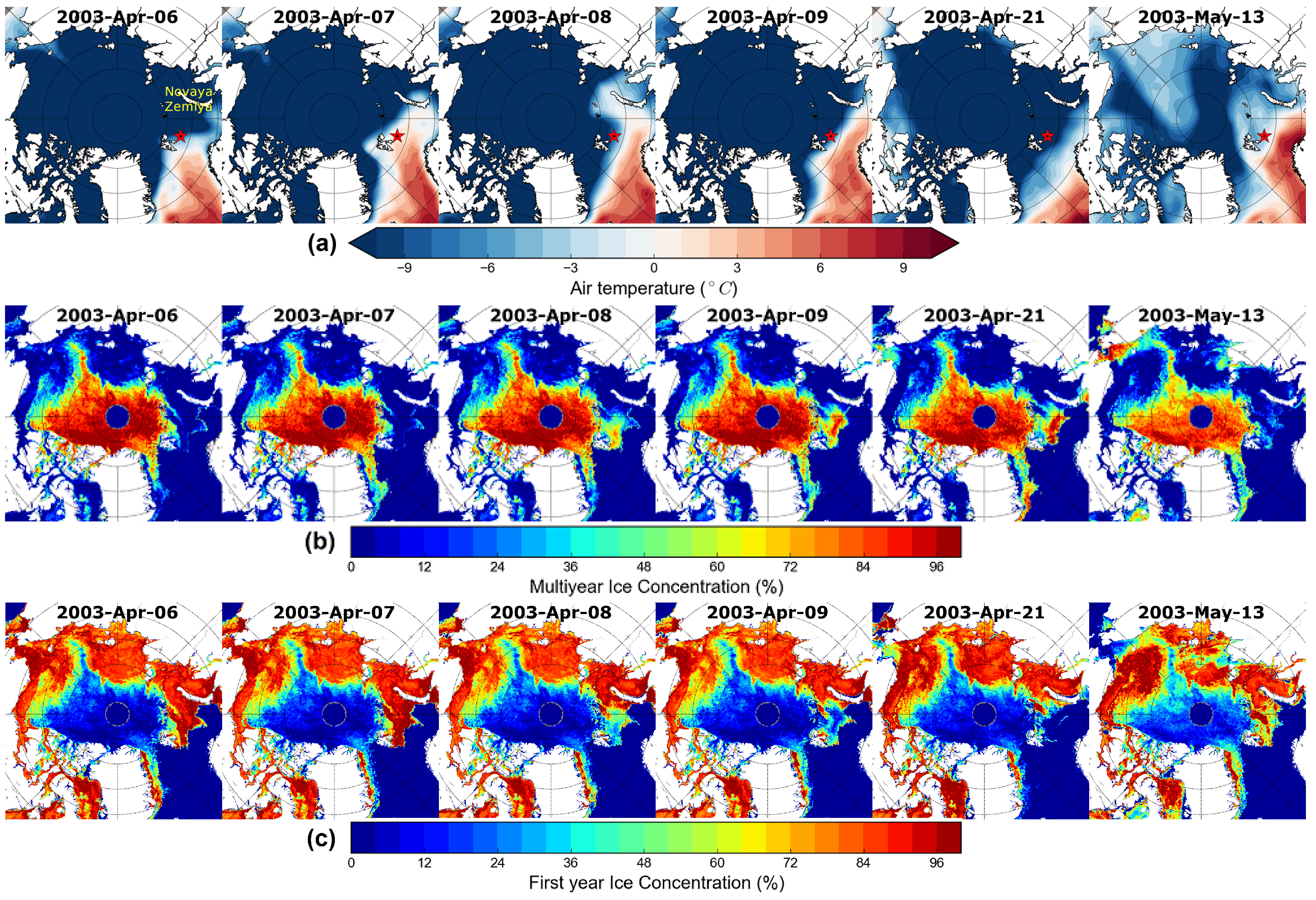
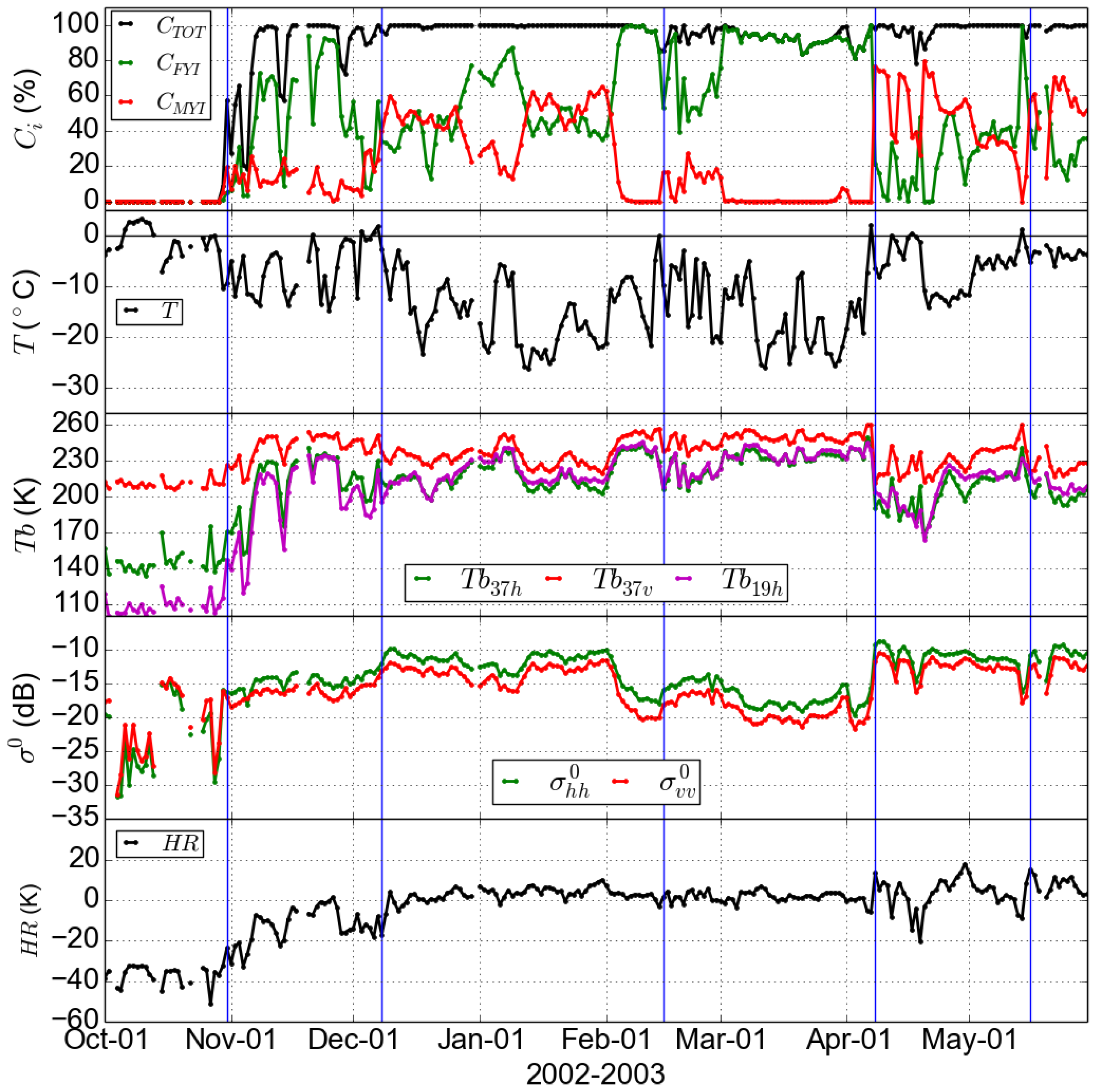
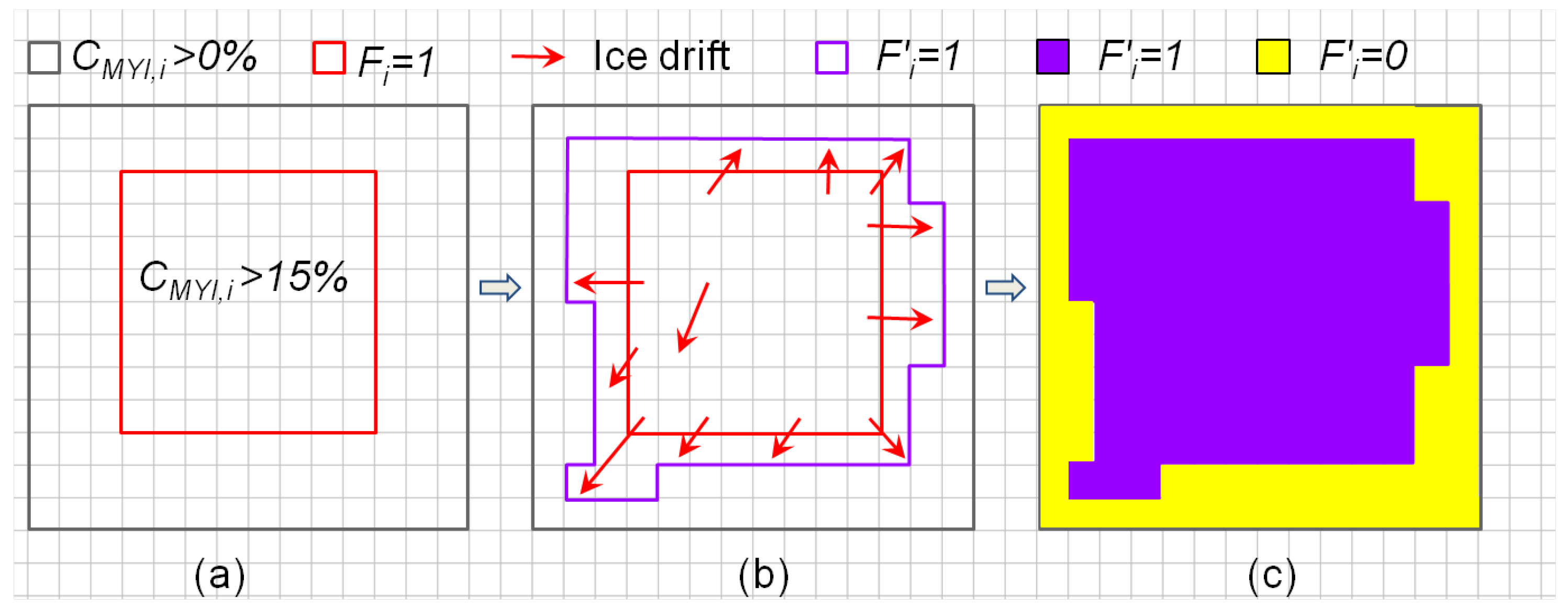
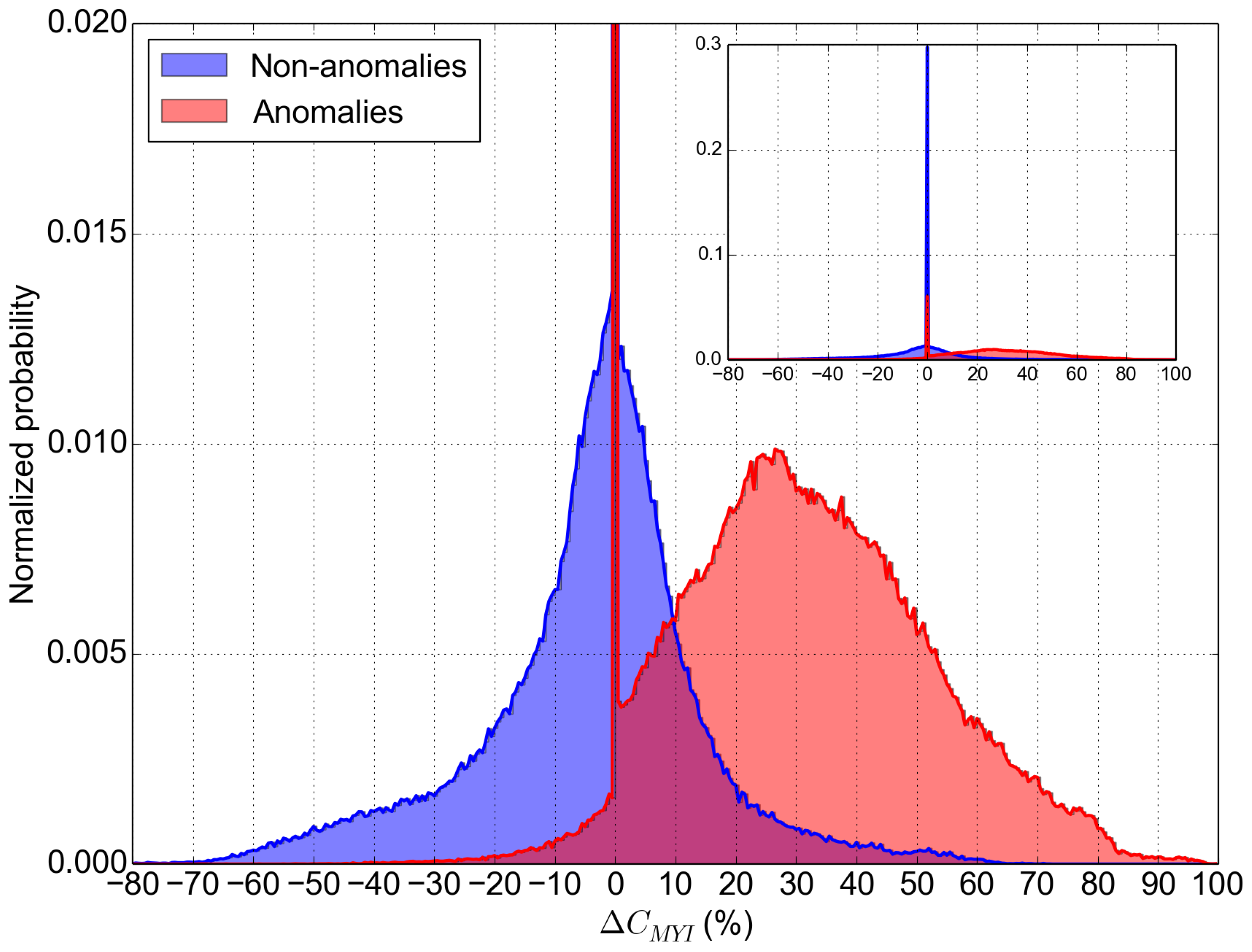
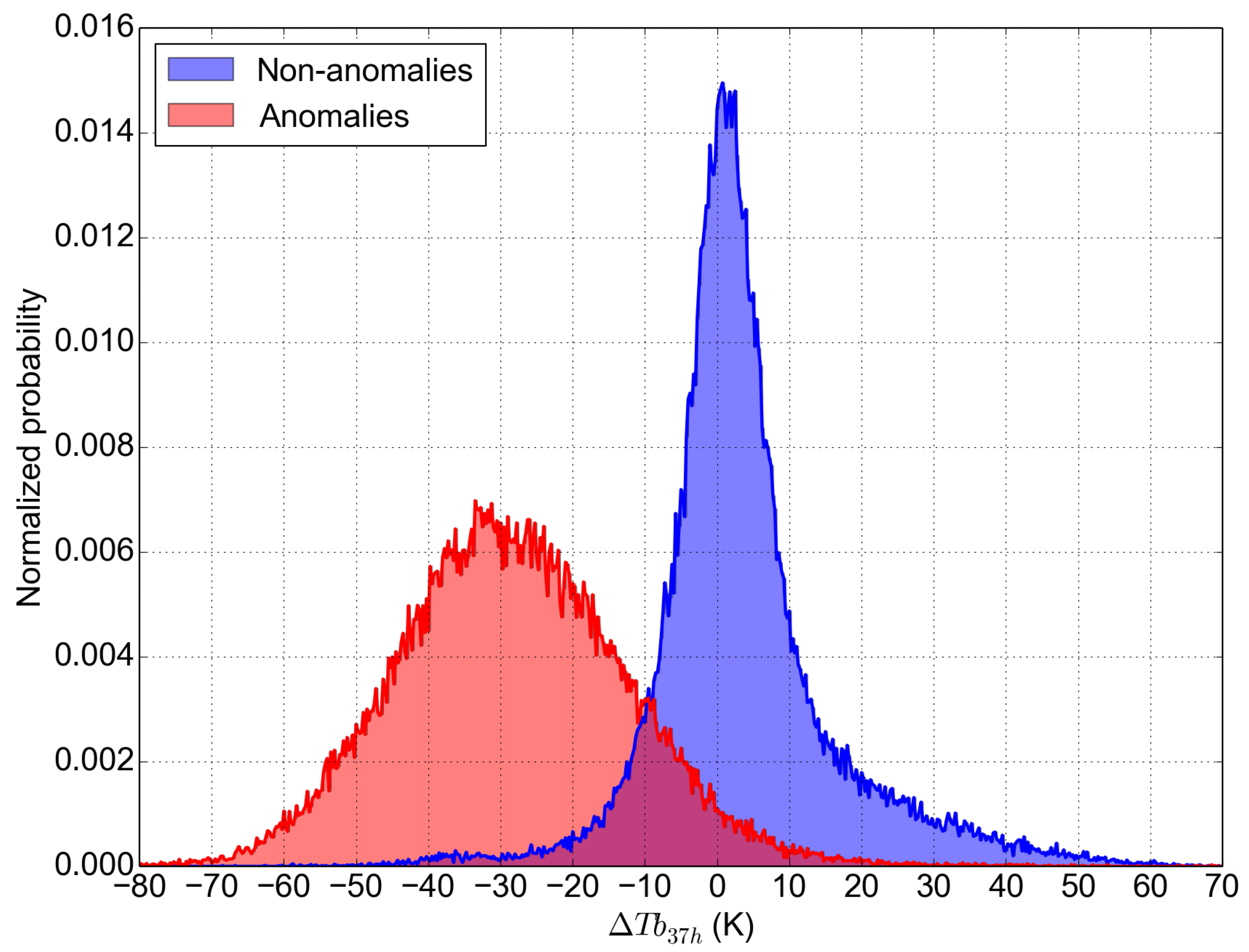
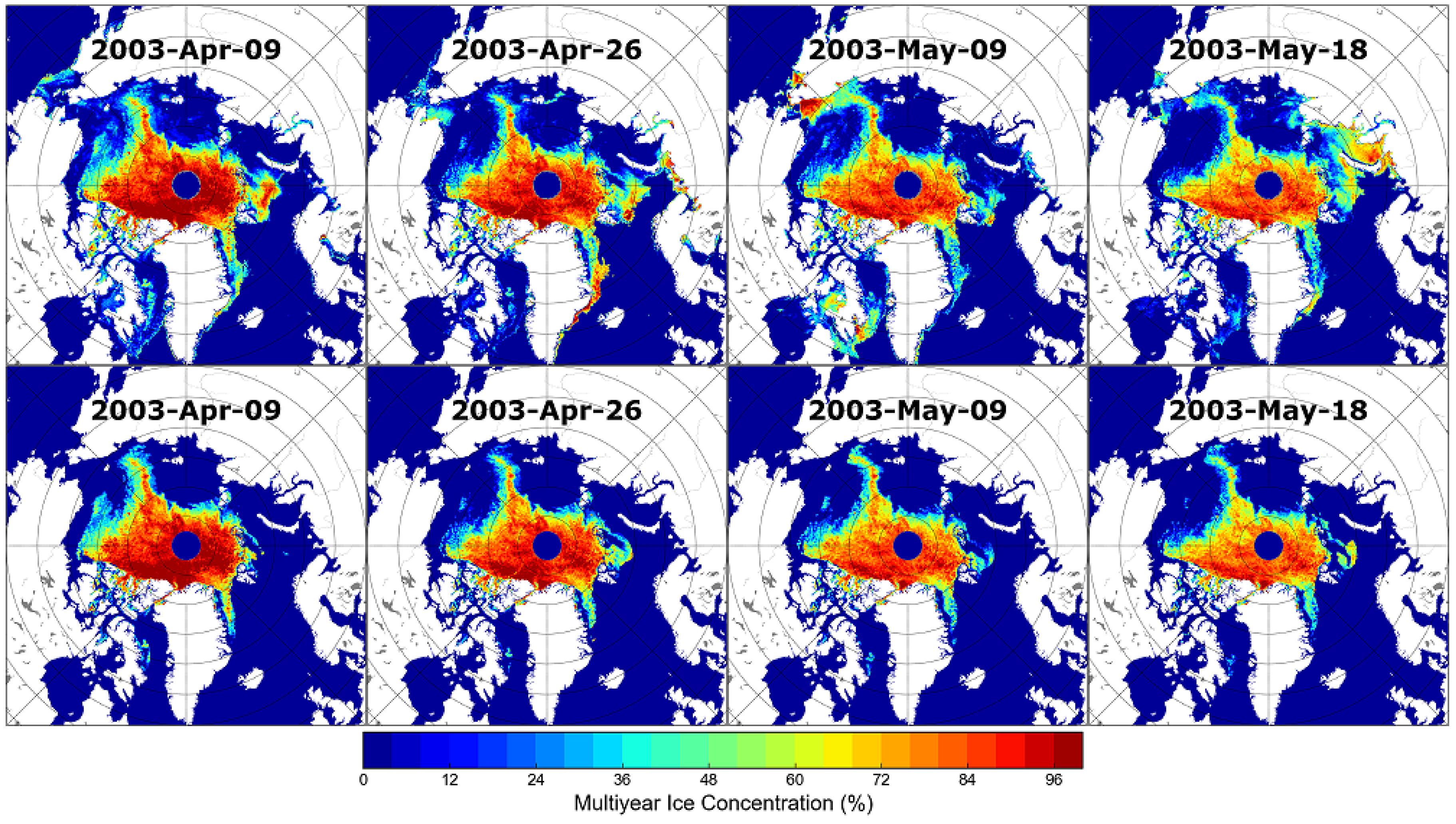
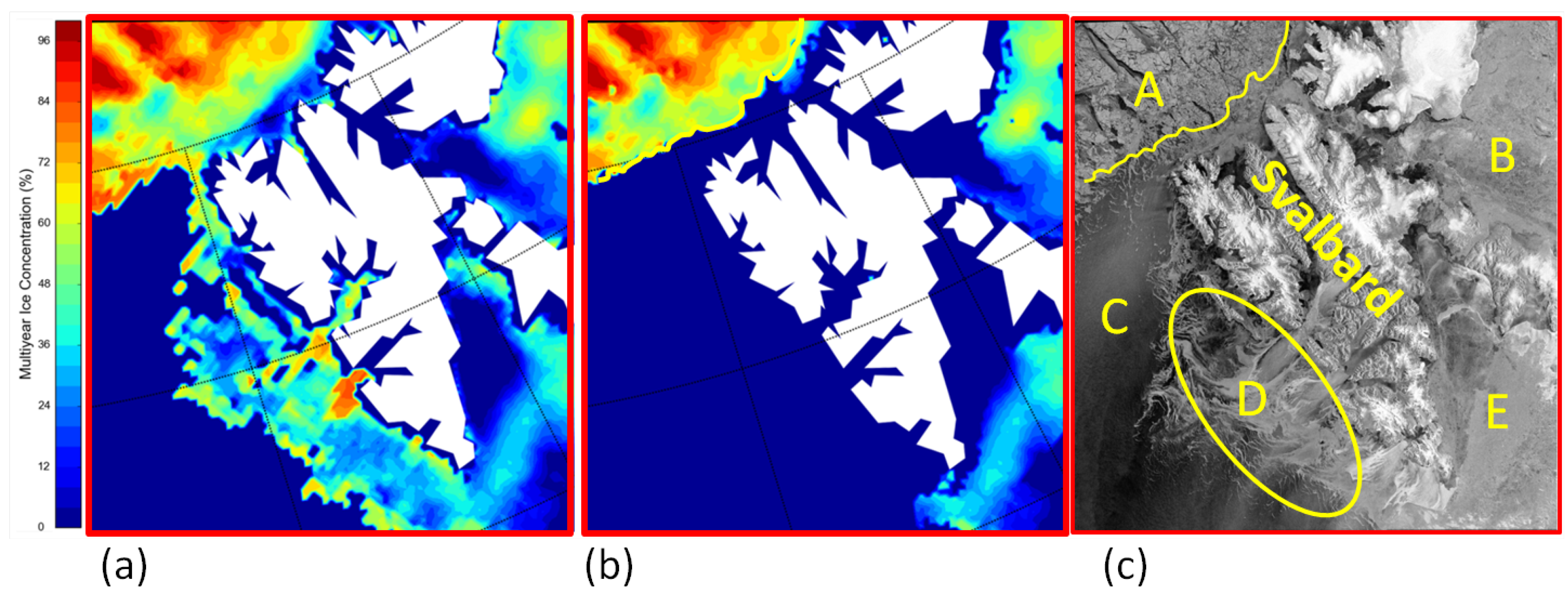
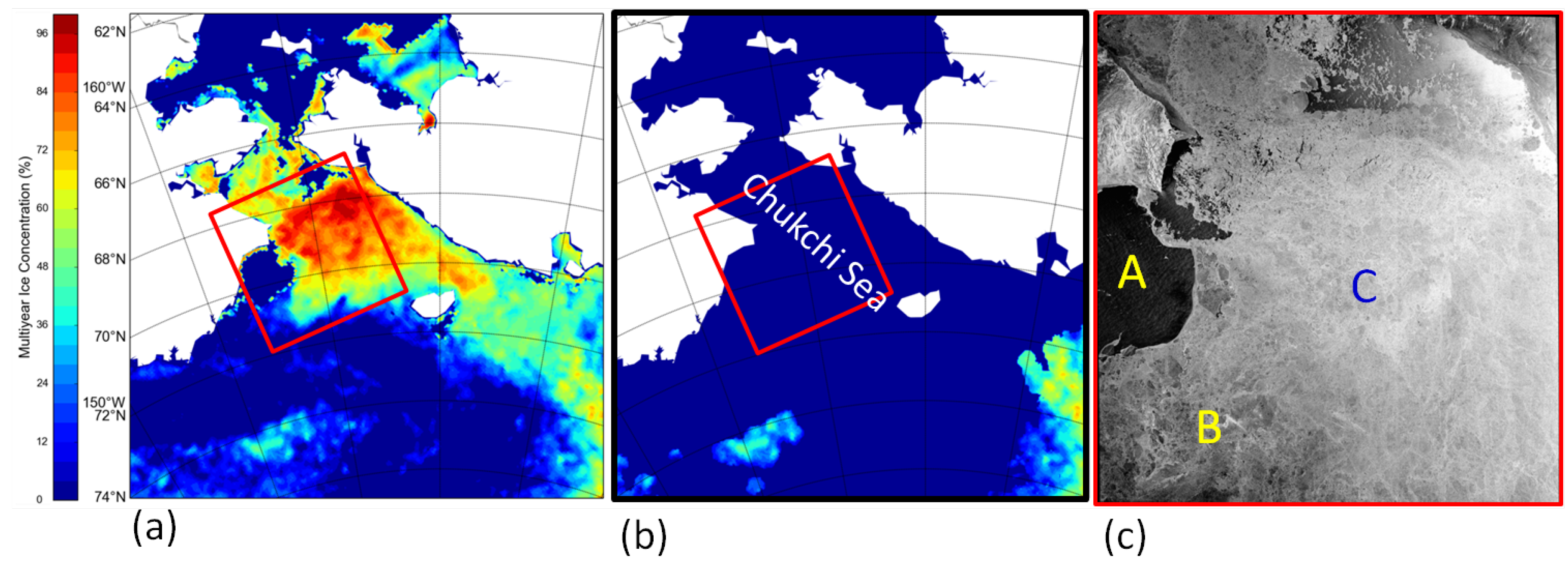
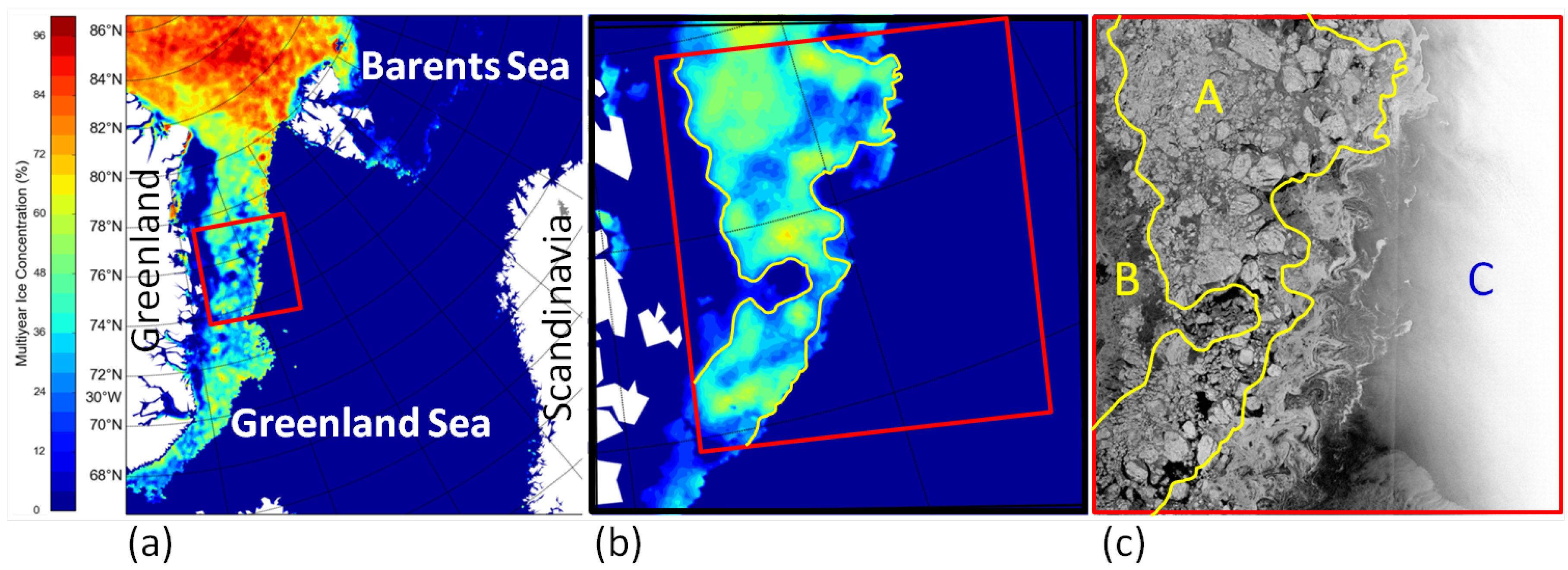
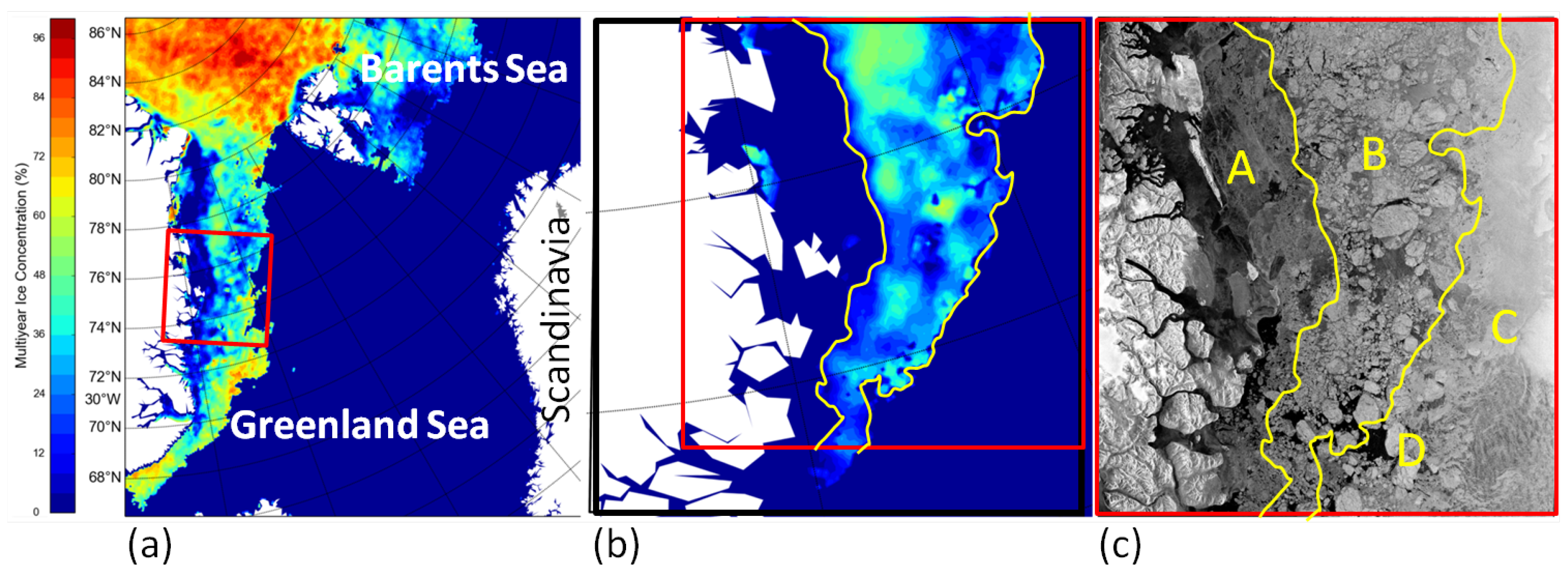
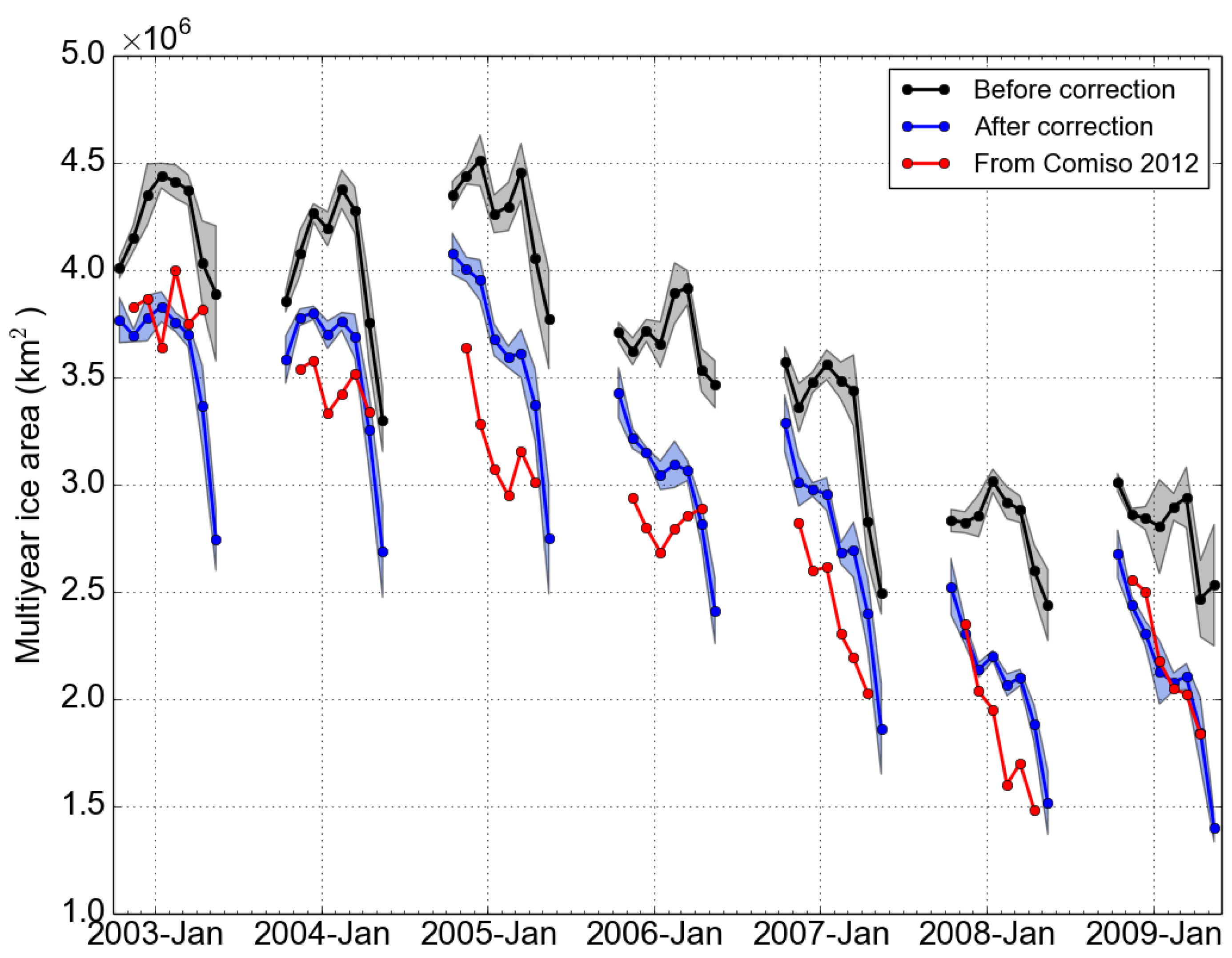
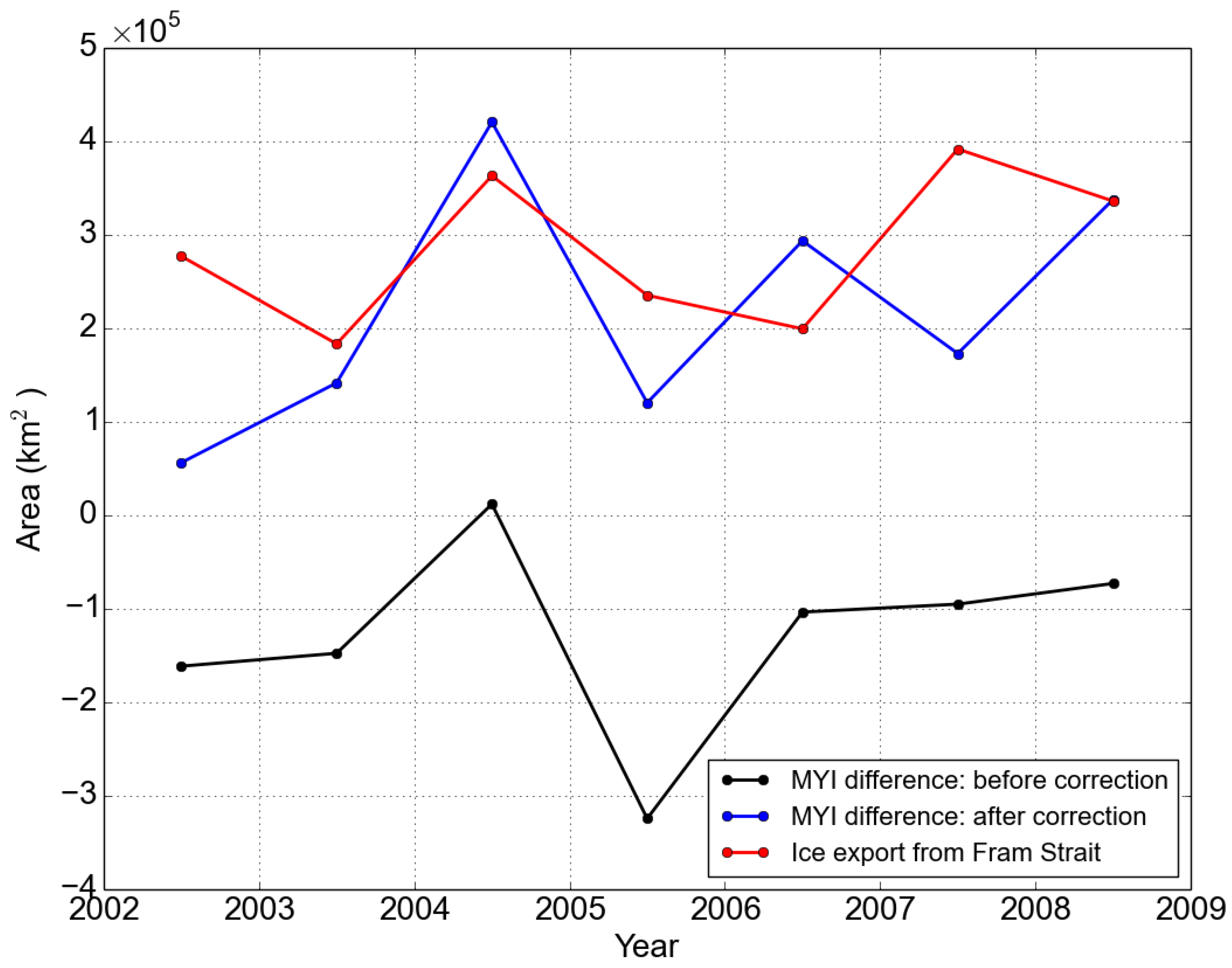

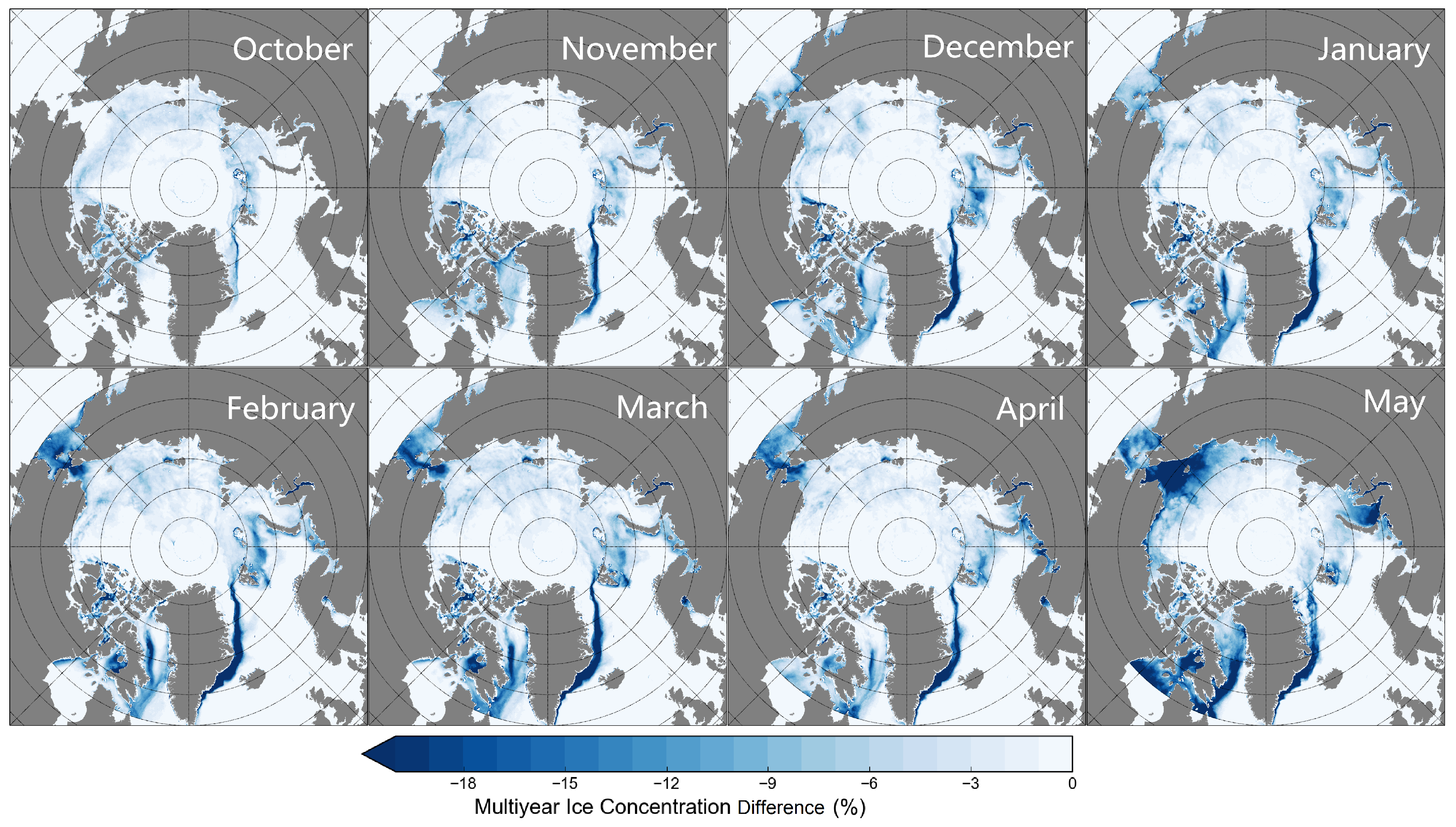
| Correction Phase | Oct | Nov | Dec | Jan | Feb | Mar | Apr | May |
|---|---|---|---|---|---|---|---|---|
| Ice drift | 98.64 | 99.52 | 99.69 | 99.73 | 99.80 | 99.85 | 99.78 | 99.74 |
| Snow wetness/metamorphism | 1.36 | 0.48 | 0.31 | 0.27 | 0.20 | 0.15 | 0.22 | 0.26 |
© 2016 by the authors; licensee MDPI, Basel, Switzerland. This article is an open access article distributed under the terms and conditions of the Creative Commons Attribution (CC-BY) license (http://creativecommons.org/licenses/by/4.0/).
Share and Cite
Ye, Y.; Shokr, M.; Heygster, G.; Spreen, G. Improving Multiyear Sea Ice Concentration Estimates with Sea Ice Drift. Remote Sens. 2016, 8, 397. https://doi.org/10.3390/rs8050397
Ye Y, Shokr M, Heygster G, Spreen G. Improving Multiyear Sea Ice Concentration Estimates with Sea Ice Drift. Remote Sensing. 2016; 8(5):397. https://doi.org/10.3390/rs8050397
Chicago/Turabian StyleYe, Yufang, Mohammed Shokr, Georg Heygster, and Gunnar Spreen. 2016. "Improving Multiyear Sea Ice Concentration Estimates with Sea Ice Drift" Remote Sensing 8, no. 5: 397. https://doi.org/10.3390/rs8050397
APA StyleYe, Y., Shokr, M., Heygster, G., & Spreen, G. (2016). Improving Multiyear Sea Ice Concentration Estimates with Sea Ice Drift. Remote Sensing, 8(5), 397. https://doi.org/10.3390/rs8050397





